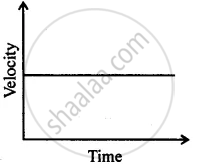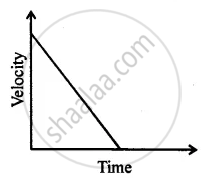Advertisements
Advertisements
प्रश्न
The velocity-time graph (Fig. 8.5) shows the motion of a cyclist. Find (i) its acceleration (ii) its velocity and (iii) the distance covered by the cyclist in 15 seconds.

उत्तर
Velocity-time graph is a straight line parallel to the time axis, so, the velocity of the cyclist is constant.
(i) Acceleration = 0
(ii) At, f = 15 s velocity = 20 m s’1 (from the given graph)
(iii) Distance covered by the cyclist in 15 s
= Area under v - t graph during that time interval
= 20 ms’1 x 15 s
= 300 m.
APPEARS IN
संबंधित प्रश्न
A train starting from a railway station and moving with uniform acceleration attains a speed 40 km h−1 in 10 minutes. Find its acceleration.
A car acquire a velocity of 72 km per hour in 10 second starting from rest. Find
(1) the acceleration,
(2) the average velocity, and
(3) the distance travelled in this time.
A freely falling object travels 4.9 m in 1st second, 14.7 m in 2 nd second, 24.5 m in 3rd second, and so on. This data shows that the motion of a freely falling object is a case of :
Which of the following could not be a unit of acceleration?
If a stone and a pencil are dropped simultaneously in vacuum from the top of a tower, then which of the two will reach the ground first? Give reason.
State how the velocity-time graph can be used to find
The acceleration of a body
The velocity-time graph of a body in motion is a straight line inclined to the time axis. The correct statement is ___________
Can you suggest a real-life example about the motion of a body from the following velocity – time graph?

Can you suggest a real-life example about the motion of a body from the following velocity – time graph?

Draw a velocity versus time graph of a stone thrown vertically upwards and then coming downwards after attaining the maximum height.
